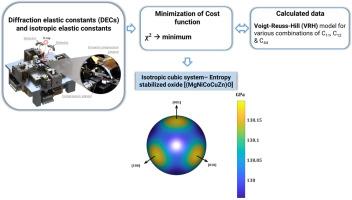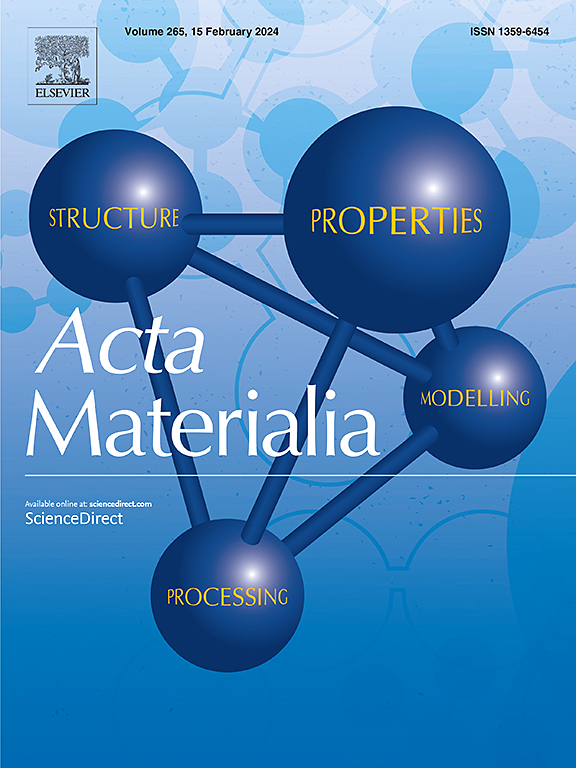Probing Elastic Isotropy in Entropy Stabilized Transition Metal Oxides: Experimental Estimation of Single Crystal Elastic Constants from Polycrystalline Materials
IF 8.3
1区 材料科学
Q1 MATERIALS SCIENCE, MULTIDISCIPLINARY
引用次数: 0
Abstract
In classical elasticity, materials with cubic symmetry are subject to specific restrictions, and only a few exhibit elastic isotropy or near-isotropy. Recent DFT calculations have shown that the entropy-stabilized oxide [(MgNiCoCuZn)O] displays elastic isotropy, with a Zener ratio close to 1. However, no experimental evidence exists to confirm this. In this study, we present a robust micromechanical approach based on the Voigt-Reuss-Hill model to estimate Single Crystal Elastic Constants (SECs) from polycrystalline materials. This method requires only two diffraction elastic constants and isotropic elastic constants for materials with cubic symmetry. Validation using phase-pure nickel showed excellent agreement with literature values, with a maximum deviation of 8.8% for C12. Applying the methodology to [(MgNiCoCuZn)O], the calculated SECs were: C11 = 219 GPa, C12 = 116 GPa and C44=51 GPa. A comparison with DFT-calculated literature values revealed significant discrepancies, with bulk and shear moduli obtained using the Voigt-Reuss-Hill average differing by 25% to 59%. To investigate this disparity, we performed additional DFT calculations and examined the underlying factors influencing these results. This study not only introduces a reliable and straightforward methodology for SEC estimation for cubic materials but also provides the first experimental SEC values for [(MgNiCoCuZn)O] entropy-stabilized oxides under ambient conditions. These findings are crucial for developing accurate interatomic potentials in future.

在经典弹性中,具有立方对称性的材料受到特定限制,只有少数材料表现出弹性各向同性或接近各向同性。最近的 DFT 计算表明,熵稳定氧化物 [(MgNiCoCuZn)O] 显示出弹性各向同性,齐纳比率接近 1。在本研究中,我们提出了一种基于 Voigt-Reuss-Hill 模型的稳健微机械方法,用于估算多晶材料的单晶弹性常数 (SEC)。这种方法只需要两个衍射弹性常数和立方对称材料的各向同性弹性常数。使用相纯镍进行的验证表明,该方法与文献值非常吻合,C12 的最大偏差为 8.8%。将该方法应用于[(MgNiCoCuZn)O],计算出的 SEC 分别为C11 = 219 GPa,C12 = 116 GPa,C44 = 51 GPa。与 DFT 计算的文献值进行比较后发现,两者之间存在很大差异,使用 Voigt-Reuss-Hill 平均值计算的体积模量和剪切模量相差 25% 至 59%。为了研究这种差异,我们进行了额外的 DFT 计算,并研究了影响这些结果的潜在因素。这项研究不仅为立方材料的 SEC 估算引入了一种可靠而直接的方法,还首次提供了[(MgNiCoCuZn)O]熵稳定氧化物在环境条件下的 SEC 实验值。这些发现对于今后开发精确的原子间电位至关重要。
本文章由计算机程序翻译,如有差异,请以英文原文为准。
求助全文
约1分钟内获得全文
求助全文
来源期刊

Acta Materialia
工程技术-材料科学:综合
CiteScore
16.10
自引率
8.50%
发文量
801
审稿时长
53 days
期刊介绍:
Acta Materialia serves as a platform for publishing full-length, original papers and commissioned overviews that contribute to a profound understanding of the correlation between the processing, structure, and properties of inorganic materials. The journal seeks papers with high impact potential or those that significantly propel the field forward. The scope includes the atomic and molecular arrangements, chemical and electronic structures, and microstructure of materials, focusing on their mechanical or functional behavior across all length scales, including nanostructures.
 求助内容:
求助内容: 应助结果提醒方式:
应助结果提醒方式:


